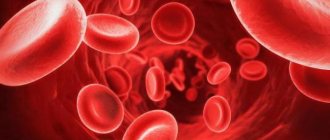In the early stages, venous blood stasis may not have noticeable symptoms, but over time, the phenomenon of venous stagnation leads to the development of chronic venous insufficiency. Over time, chronic venous insufficiency leads to severe complications that worsen the quality of life, and can even cause death. In this article we will tell you why venous stasis of blood vessels develops and explain what can happen if the disease is not controlled and treated.
Causes of venous insufficiency of the lower extremities
Chronic venous insufficiency (CVI) is a complex of clinical symptoms associated with impaired circulation in the veins.
The reasons leading to it can be different, including varicose veins, thrombosis and post-thrombotic disease. The root cause of the formation of CVI is upright posture. Blood through the veins of the legs should flow, overcoming the force of gravity: from bottom to top. This occurs due to the contraction of the lower leg muscles: they work like a pump, helping blood move through the veins. However, if a person spends a lot of time without active movement (for example, standing or sitting for a long time at work), the blood flow slows down and it can stagnate in the veins or even begin to flow in the opposite direction. Experts note that if you stand or sit at work for more than 4 hours in a row, you automatically fall into the risk group for developing so-called orthostatic edema.
Doctors also distinguish acute venous insufficiency, which occurs as a result of blockage of the deep veins of the lower extremities. In this case, blood circulation is disrupted sharply, and this pathology never forms in the superficial veins. Acute venous insufficiency is manifested by rapidly increasing swelling and severe pain.
They also often talk about lymphovenous insufficiency. The fact is that the venous and lymphatic systems are closely connected, and disruption of venous blood flow can lead to stagnation of lymph and increased edema. As a result, swelling increases as lymph accumulates in the tissues of the body.
The symptoms described above are similar to those we call when talking about varicose veins. And indeed: often both diseases are diagnosed simultaneously, the methods of treatment and prevention may be similar, but doctors emphasize that CVI can be a consequence of varicose veins, and can develop even when there are no visible signs of deformation of the vascular wall. Thus, the two diseases are certainly related, but they are different pathologies.
Violation of the venous outflow of the brain
General information about disorders of the venous outflow of the brain
Cerebral circulation occurs with the active participation of the vessels of the brain and spinal cord. If there are disturbances in the venous outflow of blood, it can be argued that the deep veins of the brain are affected. This is a pathological process and the dynamics of its development will depend on individual characteristics. Causes of impaired venous outflow of the brain
The main factors for impaired venous outflow of the brain are pulmonary insufficiency, brain tumors, heart failure, thrombosis of the veins and sinuses of the brain, compression of the veins with craniostenosis and cerebral hydrops, asphyxia of newborns, traumatic brain injuries.
Symptoms of impaired venous outflow of the brain
When the disease occurs, changes in the normal flow of blood from the brain provoke venous stagnation. In this case, the patient’s symptoms are usually the following:
- Headache;
- Nausea;
- Vomit.
An increase in temperature, swelling of the face and hyperthermia of the body are also possible. Patients may be in a comatose state with severe brain damage. The initial manifestations of the disease are characterized by noise in the head, dizziness and weakness. Performance decreases, and severe headaches occur periodically.
Thrombosis of superficial cerebral veins
It is characterized by a combination of neurological symptoms with signs of an inflammatory process. Body temperature rises, headache occurs, and there may be nausea and vomiting. Consciousness is often impaired and focal symptoms occur - paralysis of the limbs, epileptic seizures.
Thrombosis of deep veins of the brain and great cerebral vein
The clinical picture is particularly severe. The patients are in a comatose state, with signs of dysfunction of the brainstem and subcortical structures. The doctor should monitor the development of brain symptoms against the background of thrombophlebitis of the extremities or inflammatory foci in the body (postpartum period, infectious diseases).
Venous sinus thrombosis
The disease is characterized by severe headaches, swelling of the subcutaneous tissue of the face, as well as the scalp. The patient also experiences an increase in temperature, changes in consciousness (up to and including falling into a coma). The cerebrospinal fluid is clear.
Thrombosis of the sigmoid transverse sinus
This type of disease occurs most often. May be a complication of purulent otitis media. Symptoms: swelling of soft tissues, pain when chewing and turning the head.
Cavernous sinus thrombosis
Thrombosis can be bilateral - in such a case the disease occurs with complications. There are cases of aseptic thrombosis, for example, with hypertension and atherosclerosis. Thrombosis of the superior longitudinal sinus
The disease develops depending on concomitant factors. With thrombosis of the superior longitudinal sinus, overflow and tortuosity of the veins of the eyelids, temples, forehead, and crown with swelling of this area are observed. The following symptoms are also typical:
- Nosebleeds;
- Urinary incontinence (sometimes);
- Convulsive seizures.
Infectious thrombosis of the cerebral veins and sinuses can be complicated by purulent meningitis, encephalitis (inflammation of the brain) and brain abscess (focal accumulation of pus in the substance of the brain).
Treatment of cerebral venous outflow disorders
Effective treatment of disorders of the venous outflow of the brain is carried out by neurologists and infectious disease specialists. To treat venous outflow disorders, the drug Detralex is used. It is specifically designed to improve blood flow. Neck massage is also useful in some cases. However, you need to undergo a massage course only on the recommendation of your doctor.
Today there are special drugs that help eliminate venous outflow disorders. These drugs are called venotonics. Venotonics can also be used as a disease prevention. Among the most popular herbal preparations:
- Antistax gel and capsules;
- Ginkor-gel;
- "Doctor Theiss" with calendula extract;
- Escusian cream.
Exercise therapy to increase blood flow
Sometimes it is enough to work the neck to relieve the symptoms of the disease.
Long neck exercise to enhance venous drainage of the brain
To perform this exercise you need to relax. Lower your head to your chest and inhale as you lift your head up. When doing this, look up. Imagine that you are being pulled upward by an invisible thread. Lower your head and exhale. Repeat the exercise 6-7 times.
Exercise to relax your head
Sit on a chair and rest your hands on the back. Tilt your head back, completely relaxing your body. Breathe deeply and slowly. Perform the exercise in two or three passes.
Exercise “draw a figure eight” to enhance venous outflow of the brain
Relax and use the top of your head to draw an imaginary figure eight in the air. Breathe freely. Repeat the exercise 5-6 times.
Yoga can also improve the patient's condition . It is important to know that bad habits (smoking, alcohol, fatty foods) can provoke and aggravate the development of the disease. Review your lifestyle and try to eradicate harmful
Main risk factors for the development of CVI
We have already mentioned the main factor leading to the development of venous insufficiency - prolonged static load on the legs. Other risk factors are:
- heredity
- female
- physical characteristics - increased body weight and tall height
- taking hormonal medications (in particular, contraceptives)
- repeat pregnancies and others
Sometimes old age is considered a risk factor, but nowadays CVI, unfortunately, is getting younger, and it is often diagnosed in people under the age of 25.
How does CVI manifest?
The disease often develops unnoticed. The first signs of venous insufficiency may be heaviness in the legs, swelling that appears in the evening, and cramps. Spider veins may form. The further course of the disease may be accompanied by dryness and darkening of the skin, and the formation of characteristic spots. While walking, pain and characteristic squeezing are felt in the legs; with prolonged immobility, discomfort is also felt.
Lack of timely treatment for CVI can lead to the development of thrombosis, which can be life-threatening, or a trophic ulcer.
The classification of the disease includes several stages, from a small cosmetic defect and swelling of the lower leg, to noticeable skin changes and the appearance of an ulcer. Seeing a doctor in the early stages of the disease will help restore the health of your legs, avoiding surgical intervention.
Degrees of chronic venous insufficiency of the lower extremities
There are four degrees of CVI:
Zero. At this stage, there are no clinical manifestations of the disease, except for a pronounced pattern of veins in the legs.
1st degree. Patients complain of leg pain, cramps, and a feeling of heaviness. Swelling occurs from time to time.
2nd degree. Patients report constant pain and swelling, which intensifies after physical activity. Areas of hyperpigmentation appear on the skin, itching occurs, and the skin over the affected veins becomes thinner.
3rd degree. Trophic ulcers form on the skin, which periodically open and bleed. Symptoms of thrombophlebitis are observed. The patient complains of rapid fatigue and a constant feeling of tiredness.
If the patient has no complaints during stage 0 disease, then at the third stage the patient practically loses his ability to work and cannot lead his usual lifestyle.
Why is acute venous stagnation dangerous?
According to statistics, most often acute venous stagnation occurs due to compression (or obstruction of the patency) of a vessel due to burns or injuries, or against the background of thrombosis of the deep main vein.
In thrombosis, a blood clot blocks a deep vein, disrupting the outflow of blood from the organ. When a blood clot blocks a pulmonary artery, PE occurs - pulmonary embolism . This is a deadly condition, because in the case of pulmonary embolism a person risks dying within an hour.
Treatment of venous insufficiency of the lower extremities
Venous insufficiency responds well to treatment in the early stages, but in later stages it requires complex therapy. And the first thing a person faced with a problem can do is change their lifestyle. Adjusting the diet, avoiding excessive overload, wearing the right shoes without high heels - all this matters for the condition of the venous system. It is not recommended to visit baths or saunas or overheat in the sun. Physical activity helps improve blood circulation - walking, cycling, swimming.
To increase the effectiveness of treatment, the patient must wear compression stockings to help improve blood circulation in the legs.
Doctors also prescribe medications that help increase vascular tone and improve blood circulation. If CVI is accompanied by inflammation, then anti-inflammatory drugs are additionally recommended. For severe symptoms of CVI, pain-relieving ointments are also prescribed, which can be applied topically.
All these treatment methods are used in the early stages of CVI of the lower extremities. For severe varicose veins, which the doctor identifies on ultrasound, surgical treatment is indicated. During surgery, the affected section of the vein is either removed or ligated, which cuts it off from the bloodstream.
The questions of patients who are faced with chronic venous insufficiency are answered by specialists from the Phlebology Center.
What is acute venous stasis
According to the definition of M.A. Paltsev, given in the book “Pathological Anatomy”, acute venous congestion is accompanied by a sharp shift in the equilibrium between hydrostatic and oncotic pressure in the plasma towards an increase in the first of them.
Acute venous congestion occurs when a single venous vessel suddenly becomes filled with blood. Inside the blood-filled vessel, the pressure rises sharply, which begins to displace the liquid part of the blood through the venous wall into the soft tissues: muscles and subcutaneous tissue. As a result, swelling occurs in the tissue from which this venous vessel drained blood.
Reasons for appearance
The most important factor in the occurrence of vein diseases is hereditary predisposition. It is this that determines the characteristics of the condition of tissues and blood vessels.
Another reason is associated with diseases and conditions caused by problems with venous circulation: thrombosis, trauma, varicose veins.
The third group of factors includes lifestyle: passive lifestyle, excess weight, excessive loads that involve lifting heavy objects. No less significant factors are the age category and hormonal background of the patient.
Doctors consider the following people at risk:
- athletes;
- women (pregnancy and changes in hormonal levels can affect venous circulation);
- people who have a family history of venous disease.










